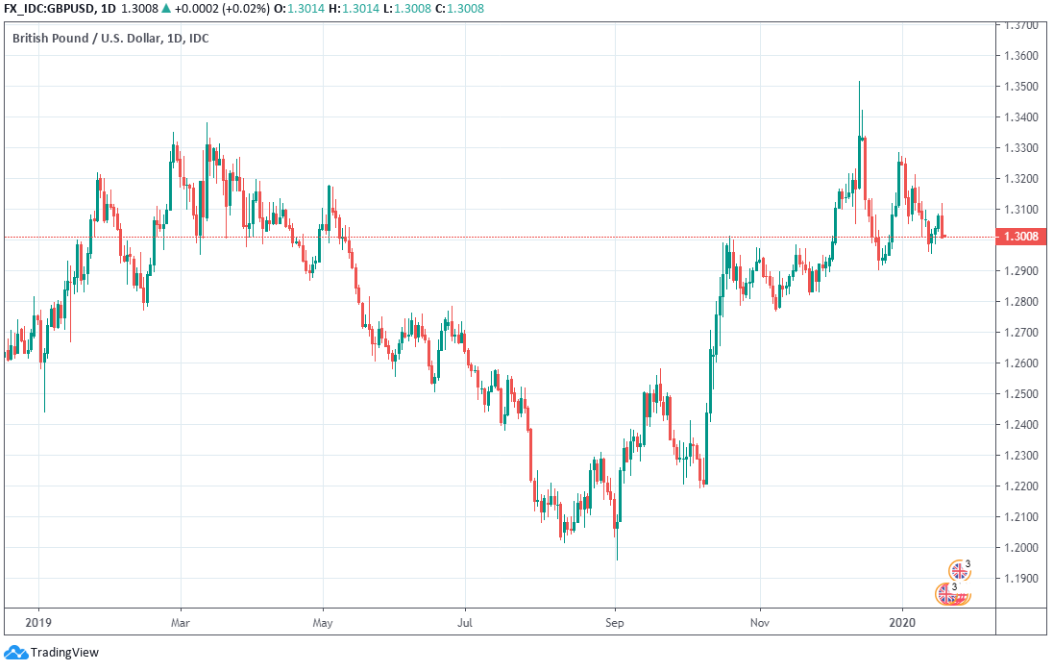Pound-to-Dollar Rate Week Ahead Forecast: Charts Point Lower as Crucial UK Economic Data Loom
- Written by: James Skinner
-
- GBP/USD technical outlook bearish ahead of key data.
- GBP fails to overcome 1.3062, retains a downside bias.
- Tuesday's jobs data, Friday PMI surveys key to outlook.
- USD eyes global data amid quiet U.S. economic calendar.

Image © Adobe Images
- GBP/USD Spot rate: 1.2990, -0.12%
- Indicative bank rates for transfers: 1.2630-1.2720
- Transfer specialist indicative rates: 1.2800-1.2870 >> Get your quote now
The Pound has ceded further ground to the Dollar at the start of the new week, and goes below the psychologically important 1.30 level once more. The losses come as Sterling endures a period of underperformance all major rivals, a trend that could dominate over the course of the coming week.
Key to the outlook for Sterling will be the releaes of jobs numbers for December and PMI data for January, due out this week, which will be key to the outlook for Sterling; the currency closed 0.29% lower against the Dollar last week on Friday after softening inflation and dire retail sales data encouraged a further waning of the post-election uptrend in the Pound-to-Dollar rate as markets increasingly price-in a January 30 interest rate cut from the Bank of England (BoE).
The exchange rate has failed to retain the upward momentum it had heading into year end and has now carved out a series of lower highs, and lower-lows on the charts since the turn of the year.
"GBP/USD can depreciate towards its 200‑day moving average of 1.2691 this week," says Joseph Capurso, strategist at Commonwealth Bank of Australia. "USD is likely to remain firm after last week’s stronger than expected US December retail sales report and housing starts confirmed the outlook for the US economy is good."
Sterling is at risk of a continued drift lower in the coming days, although economic data will have the final word on the trajectory of the currency.
Above: Pound-to-Dollar rate shown at 4-hour intervals.
"GBP/USD is still seeing a small bounce higher and probes the near term downtrend at 1.3062. While it caps, the December low at 1.2908 is exposed. Failure here would put the 4 month uptrend at 1.2838 and the 200 day moving average at 1.2689 back on the plate. A close above the downtrend is required to alleviate immediate downside pressure," says Karen Jones, head of technical analysis at Commerzbank, in a note to clients.
The Pound-to-Dollar rate had bounced briefly higher at the open of the London session Friday but failed to sustain its upward momentum and eventually closed 0.59% lower at around 1.30 for the weekend.
Friday morning's bounce brought the Pound into contact with a downward sloping trendline located at 1.3062 but the British currency failed to sustain a brief move above it and so could now be due to suffer further declines.
Jones says Sterling needs to overcome 1.3062 as a minimum to relieve itself of selling pressure, although she also notes the Pound-to-Dollar rate would then encounter resistance around 1.3285. That is the last defence of 1.3515, which is Sterling's post-election high from December. However, she and the Commerzbank team are betting against the Pound-to-Dollar rate, wagering that it will fall from 1.3060 to 1.2850 over the short-term.
Above: Pound-to-Dollar rate shown at daily intervals.
Pound Sterling: What to Watch
The Pound was the worst performing major currency last week although it still faces a plethora of risks that have scope to cause volatility in the coming days.
Tuesday marks the release of unemployment and wage growth figures for December, which have been elevated in importance by the dire messages coming from other figures released over the last fortnight.
“Looking ahead, we are fast approaching two big events: The Bank of England decision on interest rates on 30th January preceding the deadline for Brexit the very next day,” says Lee McDarby, managing director of corporate foreign exchange and international payments at Moneycorp. “Sterling continues to be stable, though this could be the calm before the storm. More information on the Bank of England’s decision this coming week could weaken the pound.”
Consensus is looking for the unemployment rate to have held steady at a multi-decade low of 3.8% in December and for wages to have grown by an annualised 3.1%, down from 3.2% in November.
The data is out at 09:30 Tuesday while IHS Markit PMI surveys are due at the same time Friday. Markets are looking for the globally as well as domestically troubled manufacturing sector to have undergone a stabilisation.
The manufacturing PMI is seen rising from 47.5 to 48.8 but remaining below the 50 level that separates industry expansion from contraction. Meanwhile the more important services PMI is seen rising from 50.0 to 51.1 this month.
“A stream of disappointing UK data has confirmed the MPC's concerns and sharply increased the odds of a January rate cut. Both November UK labour data and January PMIs will be crucial factors to watch next week. A downside surprise or signs that the data is not improving would likely cement market expectations of a cut,” says Chris Turner, head of FX strategy at ING.
Inflation and retail sales data out last week have prompted the market to go further in pricing-in a January 30 interest rate cut from the Bank of England and in the process, undermined appetite for the British currency. Retail sales revealed the economy hasn't seen any boost from the so-called Black Friday sales promotions, which it typically does, adding to mounting evidence of a final quarter economic contraction.
Inflation of 1.3% is well below the BoE's target of 2% and growth was just 0.6% in the 12 months to December, leaving it substantially below the economy’s estimated 1.25% inflation-producing rate of expansion. This could mean a rate cut is inevitable although Tuesday’s jobs data, Friday’s PMI surveys and the January 29 Autumn forecast statement could yet persuade the Monetary Policy Committee into leaving Bank Rate unchanged at 0.75% for a few months more while they observe the development of the economy.
Pricing in the overnight-index-swap market had fallen to imply on Friday, a month-end Bank Rate of 0.55%, below the current 0.75% but still a fraction above the next level down of 0.50%. And the implied Bank Rate for December 23, the final interest rate decision of the year, had fallen to 0.40%.
“This suggests that the downside to sterling may be limited. Indeed, disappointing retail sales for December sparked only a muted reaction in the currency on Friday. If anything, the risks are skewed to more pronounced GBP upside (than downside) next week, as a possible rebound in PMIs would reverse expectations of monetary easing. Hence, our asymmetric GBP/USD range with an upside skew for next week (1.2950-1.3200),” says ING’s Turner.
Current market expectations mean there’s upside as well as downside risks to Pound Sterling in the coming weeks because, if the BoE does cut this month then there’s no telling what investors might price-in for later in 2020.
And if the BoE holds rates steady and indicates it might wait a while before cutting, implied levels for subsequent months may rise. However, ING says that in such circumstances, rallies in the Pound would also be limited because markets might still fear a rate cut at a later date.
Time to move your money? The Global Reach Best Exchange Rate Guarantee offers you competitive rates and maximises your currency transfer. Global Reach can offer great rates, tailored transfers, and market insight to help you choose the best times for you to trade. Speaking to a currency specialist helps you to capitalise on positive market shifts and make the most of your money. Find out more here.
* Advertisement
The Dollar: What to Watch
The Dollar closed Friday as the second best performing major currency of the week although the calendar is devoid of market-moving economic figures for the coming days so the traders, the greenback and other currrencies will likely take their cues from an action-packed non-U.S. data calendar for the week ahead.
Investors bid for the Dollar last week after inflation was seen remaining above the 2% target of the Federal Reserve in December and following upside surprises for year-end retail sales figures that have checked the market's pessimism about the U.S. economic outlook. Market speculation was further encouraged by the signing of the long-elusive 'phase one deal' to suspend hostilities between the U.S. and China.
"The “Phase 1” deal signed in Washington is a mixed bag. If implemented in full, the deal will broaden access to China’s market for US firms and level the playing field for them. But it fails to address long-standing US grievances about state subsidies, and, crucially, lacks a clear and effective enforcement mechanism," says Eleanor Olcott, a China policy analyst at TS Lombard. "For investors, the chapters on currency stability and the expansion of bilateral trade are the most important for assessing the deal’s short-term durability since any non-compliance on these will be evident immediately."
Total retail sales rose by a respectable 0.3% in December, although that particular number was unchanged from the prior month and was also well anticipated by the consensus. Core retail sales on the other hand, rose by a sharp 0.7%, up from 0.1% in November and ahead of the 0.5% consensus.
The big move in December’s core number explains the big turnaround in the Dollar, which had ceded ground to many other majors ahead of the release but was quoted higher relative to all except the Pound and Kiwi in the wake of it. Core retail numbers are given more attention by the market because they exclude car sales from the data due to the distorting impact their large price tags can have on underlying trends.
"If the dollar is in for a turn south, the move could be significant. However, fast-money consensus, eager to sell dollars, currently have to cope with rising US growth expectations vs developed markets," says Martin Enlund, chief FX strategist at Nordea Markets.
Consumer prices rose 0.2% in December, according to the Bureau of Labor Statistics, when markets were looking for a 0.3% increase. The miss was enough to briefly wobble the Dollar even though the annualised rate of inflation still ticked higher from 2.1% to 2.3%, in line with expectations. Core inflation rose 0.1%, below the 0.2% consensus although the annualised rate still held steady at 2.3%. Core prices are seen as a more reliable measure of domestically generated inflation trends.
"USD could squeeze out some gains into the Jan FOMC but the broader 2020 story is cautious as green shoots in China and EZ take hold and US election uncertainty builds," says Sean Callow, a strategist at Westpac. "EUR/USD has rebounded off support within a 1.09-1.14 range. Improved background policies and a turn in industrial activity could underpin a period of EUR gains."
Time to move your money? The Global Reach Best Exchange Rate Guarantee offers you competitive rates and maximises your currency transfer. Global Reach can offer great rates, tailored transfers, and market insight to help you choose the best times for you to trade. Speaking to a currency specialist helps you to capitalise on positive market shifts and make the most of your money. Find out more here.
* Advertisement












